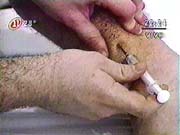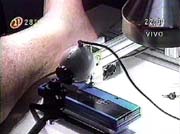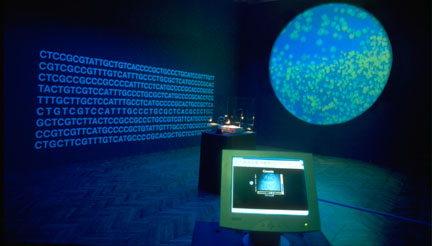However, I have not, until recently heard about BioArt. So I introduced myself and decided to show you what I found.
BioArt grows, invents or transforms living organisms through various approaches using biotechnology. It is undertaken both by scientists and artists or a collaboration between the two.
Eduardo Kac, no doubt the most well known bioartist, who coined the term 'BioArt', praised the distinct form of art for filling a need to branch out of the bordering confines dictated by traditional arts.
However the ground ahead is laden with ethical land minds. BioArt forces us to consider our roles in the evolution of species on this planet and forces us to consider deep often religious and philosophical questions as well as showcasing the advances and usefulness of biotechnology. Critiques claim that it is yet another example of humans using animals for their own personal gain, and further endangering their well being.
Ethical issues aside, BioArt generates discussion, displays the sheer beauty and elegance of nature and is pushing the boundaries of thoughts and the sciences, which is exactly what art has done for centuries.
GFP Bunny
 Perhaps the most well known BioArt exhibit is that of GFP (Green Fluorescent Protein) Bunny pictured right. GFP Bunny is of a particular BioArt known as transgenic art which deals with the transfer of genes either synthetic or natural to an organism.
Perhaps the most well known BioArt exhibit is that of GFP (Green Fluorescent Protein) Bunny pictured right. GFP Bunny is of a particular BioArt known as transgenic art which deals with the transfer of genes either synthetic or natural to an organism.GFP Bunny in particular was implanted with a gene from a jellyfish that allows the jellyfish to glow green under ultraviolet light.
The work drew mass criticism and praise from the international community but over all encouraged discussions on cultural and ethical implications, technology advancement and our notions of normalcy, heterogeneity, purity and hybridity.
Time Capsule
Another Eduardo Kac piece is Time Capsule that merges the human body and technology in order to encourage dialog on the implications of machine to human interfacing, particularly in the form of embedded microchips.



The work it's self involved a medical professional that performed the implantation of a microchip that was later scanned and the information uploaded to a database that allowed the Kac to register himself on the web using a database originally designed to register pets: the first human to do so.
 Genisis
GenisisPerhaps my favourite BioArt is Genesis. Kac again created a transgenic art piece by modifying bacteria to contain a synthetic sequence of DNA that was created by converting a sentence from the bible into Morse code and then translating the Morse code into DNA base pairs.
The sentence was chosen for it's view that human kind is by divine right the master of the world and of all living things, thus directly engaging many religious communities.
 Victimless Leather
Victimless LeatherThe last piece I wanted talk about is Victimless Leather. Yet another work that carefully straddles the moral line. It showcases the ethical issues of the current leather industry and shows us how technology could potentially bring an end to the use of animals in clothing products. It also highlights the potential use of this technology to grow specific organs for use in human transplants or growing meat for human consumption.
The moral and ethical issues were really hit home when the exhibitor of Victimless Leather had to turn off or kill the organism because it was growing faster than predicted.
BioArt exposes us to the advances of biotechnology and forces us to consider the ethical and moral issues abound. It shows us that we can take advantage of the massive advances but not before considering the disparate opinions of the community.
BioArt is with out a doubt the next frontier in art and it's here right now.
No comments:
Post a Comment